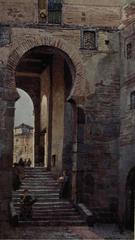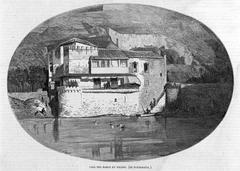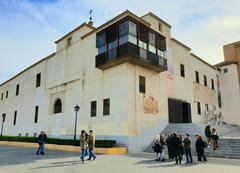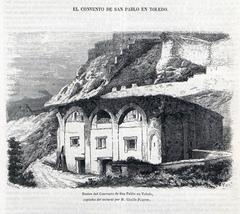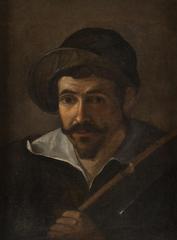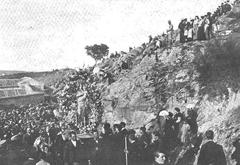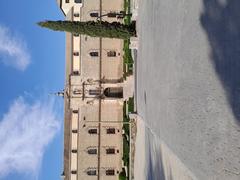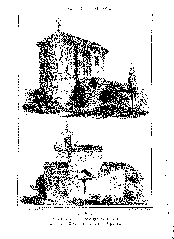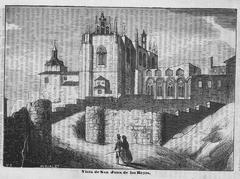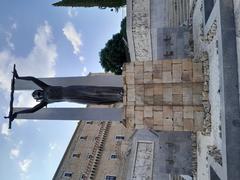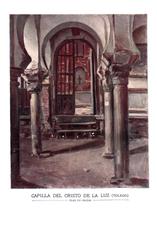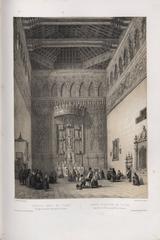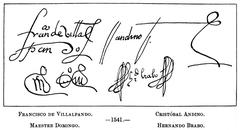
Real Colegio de Doncellas Nobles, Toledo, Spain: Visiting Hours, Tickets, and History
Date: 04/07/2025
Introduction
Located in the heart of Toledo, the Real Colegio de Doncellas Nobles is a historic institution that stands as a testament to Spain’s religious, social, and architectural legacy. Established in 1551 by Cardinal Juan Martínez Silíceo with the support of King Philip II, the Colegio was created to provide education and shelter to young noblewomen, particularly those of limited means or orphaned status. Today, the building operates as both a university residence and a museum, offering visitors a unique insight into women’s education, Renaissance and Baroque architecture, and Toledo’s cultural heritage. This guide provides detailed information about its history, significance, architectural highlights, visitor information, and practical travel tips.
For further information, see: (Wikipedia, Toledo Guia Turistica y Cultural, Historias de Toledo).
Historical Overview
Foundation and Early Purpose
Founded in 1551, the Real Colegio de Doncellas Nobles was envisioned as a charitable and educational institution for young noblewomen, emphasizing both religious and secular instruction. The founding statutes required “limpieza de sangre” (purity of blood), reflecting the era’s focus on religious and social lineage. The Colegio’s mission was to prepare women for dignified roles in society, whether through marriage or a religious vocation, providing dowries to graduates as a means of supporting their futures.
Evolution and Social Impact
Throughout its history, the Colegio maintained a dual patronage: the Archbishop of Toledo and the Spanish monarch each selected students, ensuring a blend of social backgrounds. The curriculum combined religious training, basic literacy, domestic skills, and cultural arts. Over centuries, the institution adapted to changing societal norms but remained a model for female education in Spain, offering rare opportunities for noblewomen to receive formal learning and social advancement.
Architectural Development
The original 16th-century building showcases Renaissance symmetry and clarity, with a central courtyard surrounded by arcaded galleries. Over time, Baroque and Neoclassical elements were added, most notably during the 18th-century renovations led by architect Ventura Rodríguez. The façade features classicist portals with royal and founder’s insignias, while the interior houses artistic treasures such as the Baroque chapel and the Renaissance sepulcher of Cardinal Silíceo, sculpted by Ricardo Bellver.
Architectural and Artistic Highlights
The Main Courtyard
A classic example of Castilian Renaissance design, the courtyard features granite columns, arcaded galleries, and a tranquil ambiance, reflecting the institution’s educational and communal spirit.
The Chapel
The Baroque chapel is a masterpiece, with a single nave and barrel vault, adorned with altarpieces dedicated to the Virgen de los Remedios, the Virgen del Pozo, and Saint Jerome. Gilded woodwork, expressive iconography, and paintings by artists such as José Muriel Alcalá underscore the religious and artistic importance of the space.
The Sepulcher of Cardinal Silíceo
Located within the chapel, the founder’s sepulcher is a Renaissance work rich in classical motifs and sculptural reliefs depicting significant episodes in the Colegio’s history.
Additional Artistic Details
Throughout the building, visitors will find period furniture, decorative ironwork, carved wooden doors, and artworks that highlight Toledo’s artisanal heritage.
Educational Model and Daily Life
The Colegio’s educational program, shaped by Catholic Reformation ideals, centered on piety, discipline, and practical skills:
- Religious instruction: Daily prayers, catechism, and Mass attendance.
- Literacy and basic education: Reading, writing, arithmetic.
- Domestic arts: Needlework, embroidery, household management.
- Cultural arts: Music, singing, and occasionally painting.
Students lived under a cloistered, supervised regimen, with the architecture reinforcing a sense of seclusion and order. Admission balanced noble and less affluent families, fostering both charity and virtue.
(Revista de Estudios Históricos, Conventos de Toledo)
Visitor Information
Location
- Address: Calle de las Doncellas, 2, 45001 Toledo, Spain
- Access: Walking distance from Toledo Cathedral and Alcázar; best explored on foot due to Old Town vehicle restrictions.
Visiting Hours
- Open: Tuesday to Sunday, 10:00 AM – 6:00 PM
- Closed: Mondays and some public holidays
- Note: Hours may vary seasonally; check the official tourism website for current schedules.
Tickets
- Admission: Included in the “Pulsera Turística” (Tourist Bracelet), granting access to multiple Toledo monuments (approx. €12 in 2025).
- Individual Tickets: Available at the entrance or online via authorized platforms.
- Discounts: Offered for students, seniors, and groups.
Guided Tours
- Availability: Regularly scheduled in Spanish; English tours may be offered with advance booking.
- Duration: Typically 30–60 minutes
- Booking: Recommended, especially during peak seasons.
Accessibility
Due to its historic architecture, some areas have limited wheelchair access. Main courtyard and chapel are generally accessible; visitors with mobility concerns should inquire in advance.
Photography & Etiquette
- Photography: Permitted in most areas without flash; consult your guide for specific restrictions.
- Attire: Modest dress recommended, especially in the chapel.
Visitor Amenities
- Facilities: Restrooms and a small gift shop with books and Toledo souvenirs.
- Dining & Shopping: Nearby cafés and artisan shops in the Old Town.
Must-See Highlights
- Baroque Chapel: Intricate altarpieces, religious paintings, and period woodwork.
- Renaissance Courtyard: Central to the building’s layout and daily life.
- Sepulcher of Cardinal Silíceo: A focal point of the chapel’s interior.
- Historic Classrooms & Dormitories: Offering insight into the lives of former students.
Travel Tips
- Best Time to Visit: Spring and autumn for pleasant weather and fewer crowds.
- Combine Visits: Explore nearby sites such as the Toledo Cathedral, Monastery of San Juan de los Reyes, and the Alcázar.
- Footwear: Wear comfortable shoes due to cobblestone streets and stairs.
- Virtual Tours: Explore parts of the Colegio online via a 360º HD virtual tour.
(Asturnatura, Historias de Toledo)
Frequently Asked Questions (FAQ)
Q: What are the visiting hours of the Real Colegio de Doncellas Nobles?
A: Open Tuesday to Sunday, 10:00 AM – 6:00 PM; closed Mondays and some holidays. Check for seasonal updates.
Q: How do I purchase tickets?
A: Admission is included in the Tourist Bracelet or can be purchased individually at the entrance or online.
Q: Is the site wheelchair accessible?
A: Partial accessibility; contact the site for details.
Q: Are guided tours available in English?
A: Primarily in Spanish; English tours may be available with advance booking.
Q: Can I take photographs inside?
A: Yes, generally permitted without flash.
Cultural and Social Impact
The Colegio played a pivotal role in the advancement of women’s education in Spain, serving as a model for similar institutions. Its archives remain a valuable resource for historians and genealogists. Alumni often became influential figures, either within noble households or religious orders, contributing to the evolution of social roles for women in early modern Spain.
Plan Your Visit
For the best experience:
- Confirm visiting hours and tour availability before arrival.
- Consider purchasing the Tourist Bracelet for multi-site access.
- Download the Audiala app for audio guides and interactive maps.
- Engage local guides for deeper historical context.
- Follow official Toledo tourism channels for real-time updates.
Related Toledo Historical Sites
Conclusion
A visit to the Real Colegio de Doncellas Nobles offers a profound journey through Toledo’s multifaceted history, blending educational innovation, religious tradition, and architectural splendor. As a pioneering institution for noblewomen’s education, the Colegio encapsulates the evolving social dynamics of 16th-century Spain. Its Renaissance and Baroque architecture, artistic heritage, and ongoing educational role make it an essential stop for travelers seeking to understand Toledo’s cultural identity.
Plan your visit today, and immerse yourself in the enduring legacy of the Real Colegio de Doncellas Nobles.

